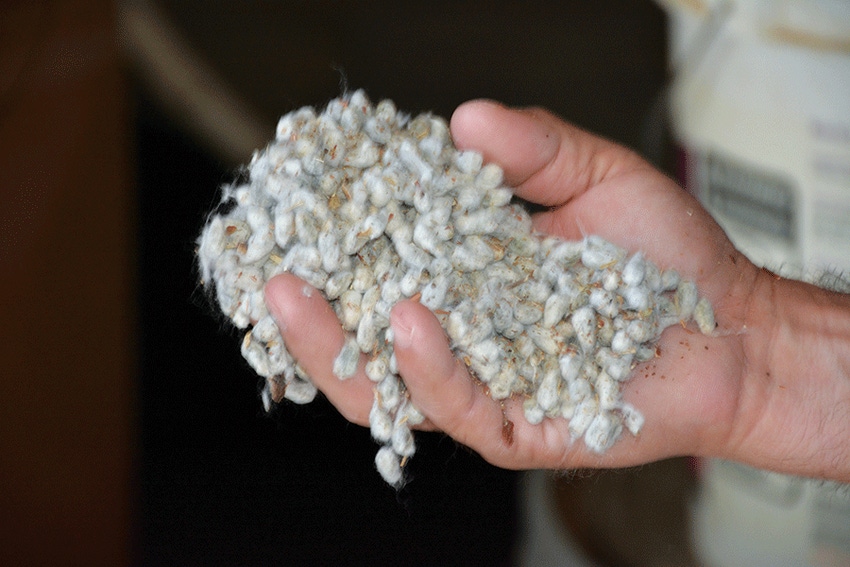
Cotton producers have started receiving checks for their certified acres in the ginning cost share program — what amounts to “rocket speed for the government,” says Craig Brown, National Cotton Council vice president for producer affairs.

CRAIG BROWN
CRAIG BROWN“This has been about as seamless an implementation of a government program as we’ve seen,” he said at the joint annual meeting of the Mississippi Boll Weevil Management Corporation and the Mississippi Farm Bureau Federation Cotton Policy Committee.
“Credit goes to Secretary Vilsack and the Farm Service Agency, but a big share of credit goes to those in the cotton industry who worked so hard and were so effective in making a case to the secretary that cotton farmers needed assistance. It would have been easy for him to say, ‘No, good luck, go to Congress and see if you can get some help.’ But he found some very innovative authority to provide a one-time economic shot in the arm for cotton producers.”
Council and industry leaders asked Secretary Vilsack more than a year ago, Brown says, “to use what we thought was his authority to implement a cottonseed program in the farm bill. We made a very strong economic case; we enlisted bankers, representatives from all industry segments — a massive effort to make the case for cottonseed as an other oilseed crop.
“In February, Secretary Vilsack said he didn’t have the authority to do it, but — and this is extraordinary — he found some authority that he could use, and the result is the ginning cost share program. It’s not a panacea, it’s not going to rescue the cotton industry from the economic doldrums, but it’s welcome.”
Efforts continue on cottonseed legislation
Brown says the council and industry leaders haven’t given up on the concept of having cottonseed designated as a covered commodity. “We don’t think Secretary Vilsack will exercise his authority to do this, nor can we speculate whether subsequent secretaries would exercise the authority we believe is in the farm bill. Instead, we’re turning to a legislative approach. It will be a very difficult task, and will involve changes in the way programs are operated.
“When a legislative opportunity presents itself, we want to be ready, and to be sure what we’re proposing is somewhat budget neutral. We’re working closely with House and Senate ag committee staffs, and out of this we hope to have an opportunity to get this proposal into legislation.”
Another council goal, Brown says, is to try and get changes to the loan rate formula in the farm bill for the 2017 crop. “This will be a tall order as well. We’re working on ideas to mitigate these loan rate changes.”
IT’S FREE! Stay informed on what’s happening in Mid-South agriculture: Subscribe to Delta Farm Press Daily.
July 1 was a significant date for producers, he says. “That was the extended status date for farm plans for the 2016 crop year. There are major changes in the ‘actively engaged’ management requirements in order to be eligible for any farm program benefits, including the marketing loan.”
The new rule “represents a very strenuous burden of a recordkeeping and delineation of management responsibilities,” Brown says, and for many farmers there is “a lack of understanding, or misunderstanding, of what constitutes family. The rule is based on family operations as defined by law, not as defined by family tree.
“The law defines family as lineal family. Spouses and siblings of lineal family members also qualify as family members, but once you break the lineal chain, or the chain is already broken, the whole operation is considered non-family. It can’t be partially family and partially not — it’s either all family or it’s not.
Check Current Cotton Futures Prices
“The rule is very strict, and I think it’s clear it is going to be closely monitored. If you’re not familiar with it’s provisions, you need to take steps to make sure your operation is in compliance, because FSA will be enforcing it.
“This is going to affect a lot of traditional family operations,” Brown says. “It’s something to which you need to pay close attention. It’s in effect for 2016 unless you had a fall crop or had fall pasture; in that case, you will have a one-year abeyance to determine if the rule applies to your operation and to be sure you’re in compliance.”
Concern for off-label herbicides
In discussing new cotton varieties with dicamba and 2,4-D resistance traits, Brown said there is concern about off-label applications being made — “primarily dicamba, since those are the dominant traited varieties that have been planted.
“I express this concern as a representative of an organization that has been fighting diligently to get this chemistry labeled for cotton. We’re now going into the second season of dicamba-traited cotton varieties on which producers are not allowed to spray dicamba.
“The easiest way to lose this chemistry — or to further delay the much-drawn-out registration process — is to have a bunch of off-label applications. I would encourage everyone to resist temptation, follow the rules, and observe label restrictions on these new cotton varieties.”
About the Author(s)
You May Also Like




